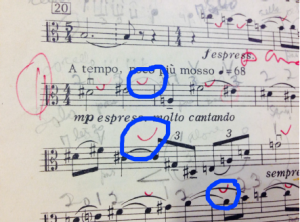Sydney Howard and Dr. Claudine Bigelow, Music
For my project, I did extensive research on viola pedagogue, Karen Tuttle. Even after her
passing, Ms. Tuttle remains an important influence in the fields of viola pedagogy and modern
viola playing. She taught some of todays most influential viola professors, and through their
teaching, Ms. Tuttle’s legacy continues to live on.
I was able to spend over a hundred hours reading and cataloging her materials. I first spent many
hours immersed in the collection, trying to understand how best to organize it. It includes Ms.
Tuttle’s sheet music (some of which is extensively marked), cards, letters, photographs, and
notes. I separated the marked music from unmarked music as well as the rest of her materials
into their separate categories. I gathered data about each of the pieces in the collection into a
single document so that the Special Collections staff has a greater understanding of what this
collection contains. I then put each individual item in its own acid-free folder and labeled it. This
way, everything might be preserved for many generations of violists and other library patrons
who want to learn from the collection.
I then went through her sheet music, identifying strange markings that were not easily
discernible. I contacted several of her viola students, including, Professor Edward Gazouleas
from Indiana University and Professor Carol Rodland of the Eastman School of Music. Through
extensive interviewing, I was able to get interpretations for the several of the markings in order
to compile a key. This key will aid patrons in interpreting Karen Tuttle’s music and better enable
them in understanding her thought process as she learned and performed a piece of music. Her
notes are rich with wisdom and an understanding in the process behind playing music.
Sample of Karen Tuttle’s Sheet Music, with markings circled:

This example of markings is something recognizable to nearly every student of Karen Tuttle.
They are the markings of her famous “coordination” technique. This marking implies a physical
sensation and a musical impulse in a long note. She desired that the student “go through” the
note. This concept was central to Ms. Tuttle’s teaching and is described in a different way by
each of her students that I interviewed. My understanding is that this ‘scoop’ marking meant that
one should re-balance the right hand so that more weight came into the pinky and ring fingers
(Ms. Tuttle referred to this as a “re-pull” of the bow). Meanwhile, one would release the torso
(neck, chest, stomach, pelvis). This would create a blossom at the end of the note. The ‘scoop’
written in music is an instruction to the player to apply these principles and actions on that
particular note or moment in the music.
It was quite incredible to study these materials and to gain an insight into the mind of such an
important viola figure. I have been able to apply these viola techniques that I have now
extensively researched in my own playing. I have benefited tremendously from learning to think
about viola in such a different and special way. It was also amazing to interview several viola
professors about Karen Tuttle. It was truly inspiring to see this woman come alive as they fondly
recalled their time studying with her. She was an incredible woman and an even better viola
teacher, and I am grateful that I have been able study her materials and make them accessible to
the patrons of the Harold B. Lee Library.
